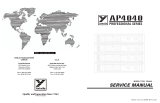Page is loading ...

Solar Face
Si or Ge Fuzz Face with
a magic bias dial
Contents of this document are ©2022 Pedal Parts Ltd.
No reproduction permitted without the express written
permission of Pedal Parts Ltd. All rights reserved.
FuzzPup

IMPORTANT
Before you start...
Grab the general build doc that covers all FuzzPup V2 builds.
Most of the information you need for this build is in there.
Read it? OK, carry on.

Schematic + BOM
This is the full schematic including the following optional parts:
Voltage Inverter (D1, IC1, C6, C8) to make a positive ground build (using PNP
transistors) work with standard negative ground supplies.
To use the voltage inverter simply add these parts. You also need to jumper the
pads marked J2 on the back of the PCB with a blob of solder. You can use a 7660
or MAX1044.
If you’re building a NPN / negative ground circuit, so don’t require the inverter,
leave these parts out and jumper the two pads marked as J1 on the back of the
PCB with a blob of solder.
Smoothing Caps (C4, C5) to prevent high frequency oscillation on builds with
higher gain silicon transistors. These aren’t required on builds using germanium
transistors in the standard Fuzz Face gain ranges.

Schematic + BOM PNP/Ge
R1 100K
R2 33K
R3 470R
C1 1u elec
C2 10n
C3 22u elec
C4 Empty
C5 Empty
C6 10u elec
C7 22u elec*
C8 10u elec
D1 1N4148
D2 1N4001
IC1 TL7660SEPA
Q1-2** Ge Fuzz Face set
BIAS 5KB
FUZZ 1KC
VOL 250KA
T1 47-50K
T2 10K
Parts listed in green are the optional
voltage inverter. If you’re not adding this
leave these out and connect the J1 pads
on the back of the board as detailed on
the previous page with a blob of solder.
You’ll have to wire it as positive ground if
you’re using PNP transistors and aren’t
using the inverter.
*This is the largest value we
could find that is short enough
to physically fit into the build.
Use 10u if your 22u are too big.
**Typical transistor gain values
for a Fuzz Face are:
Q1 - 70ish
Q2 - 120ish

Schematic + BOM NPN/Si
R1 100K
R2 33K
R3 470R
C1 1u elec***
C2 10n
C3 22u elec***
C4 *
C5 *
C6 Empty
C7 22u elec‡
C8 Empty
D1 Empty
D2 1N4001
IC1 Empty
Q1-2** BC108 etc
BIAS 5KB
FUZZ 1KC
VOL 250KA
T1 47-50K
T2 10K
*You should use small value ceramic caps for
C4-5. The larger the value the more
top-end will be removed from the signal.
We go for C4 - 470p, C5 100p
**Feel free to try any low-medium gain BJT
transistors.
***Reverse C1 and C3 for this configuration.
‡This is the largest value we could find that is
short enough to physically fit into the build. Use
10u if your 22u are too big.
Don’t forget to jumper the J1 pads.
This configuration will
also work for NPN
Germanium transistors,
but you won’t need C4-5.


PCB layout ©2022 FuzzDog

FuzzDog.co.uk
Everything else you need is in the
general build doc you’ve already read.
Head back to that.
/













